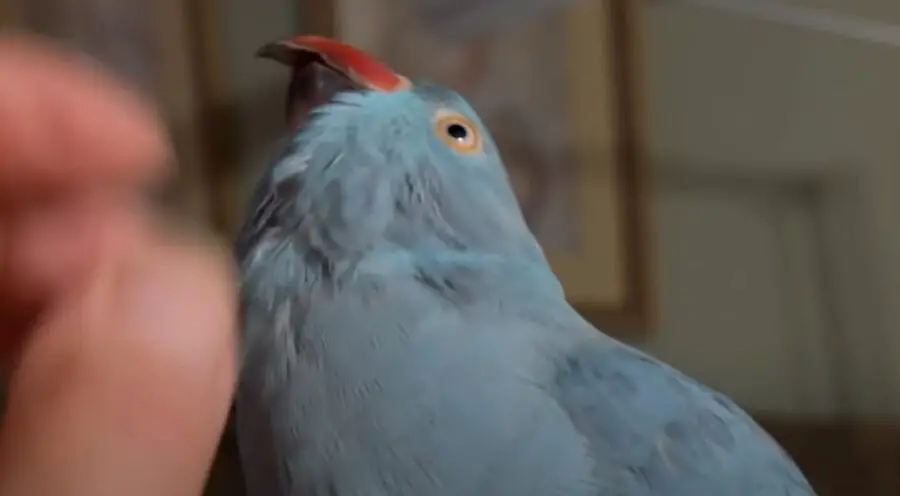Have you just noticed that your budgies eyes are dilate, are you wondering why do parrots eyes dilate.
Are they rapidly dilate and contracting their pupils?
This action is called eye pinning which I will cover below.
Why Do Parrots Eyes Dilate
Parrots’ eyes dilate as a response to changes in lighting conditions, arousal levels, or emotional states. The dilation of the pupils in parrots, as in many other animals, this is known as eye pinning and serves several purposes:

Adjusting to Light
Parrots’ eyes dilate to allow more light to enter the eye in darker environments, improving their vision in low-light conditions. This dilation helps them gather more visual information and enhances their ability to navigate and perceive their surroundings effectively.
Emotional State
Parrots’ pupils can also dilate in response to their emotional state. When they are excited, stimulated, or agitated, their pupils may dilate. This can occur when they are engaging in playful activities, receiving attention, or feeling threatened or scared.
Communication
Pupil dilation in parrots can also be a form of communication. For example, a parrot may dilate its pupils as a sign of interest or curiosity when observing something new or when interacting with their human or avian companions.
It’s important to note that pupil dilation alone may not always indicate a specific emotion or behavior in parrots. Other body language and behavioral cues should be considered to interpret the overall context and the parrot’s state of mind.
What Is Eye Pinning
Eye pinning, also known as “eye flashing” or “eye dilation,” is a behavior commonly observed in birds, including parrots. It refers to the rapid and noticeable contraction and expansion of the pupils, resulting in a flickering or flashing effect. Eye pinning is a form of non-verbal communication and can convey various emotions and intentions.
Eye pinning in birds can have different meanings depending on the context and accompanying body language.
[youtube v=”LpukwevwVQI”]
What You Should Do When Parrots Eyes Dilate
When a parrot’s eyes dilate, it can indicate various emotions or responses, so the appropriate action depends on the context and accompanying behaviors. Here are some general guidelines:
Observe the Overall Body Language
Pay attention to the parrot’s overall body language to assess the situation. Consider factors such as their posture, feather position, vocalizations, and any other behavioral cues that can provide insight into their emotional state.
Provide a Calm and Safe Environment
If the parrot’s eyes are dilated due to fear, stress, or agitation, it’s important to create a calm and safe environment. Remove any potential stressors, such as loud noises or unfamiliar people or animals. Provide a familiar and secure space for the parrot to retreat to if needed.
Avoid Aggravating the Situation
If the parrot’s eyes dilate in response to a perceived threat or stressor, it’s crucial to avoid actions that may escalate the situation. Refrain from making sudden movements, loud noises, or engaging in confrontational behaviors that could further agitate the parrot.
Assess the Need for Space
Depending on the parrot’s behavior, it may be necessary to give the bird some space and time to calm down. Respect their boundaries and avoid handling or approaching them if they appear stressed or defensive.
Offer Comfort and Reassurance
In some cases, offering comfort and reassurance may help alleviate the parrot’s stress. Speak to them in a calm and soothing tone, and observe if they respond positively to gentle interactions or familiar cues.
Why Do Parrots Eyes Dilate When Talking
Parrots’ eyes dilating when talking is not a behavior specific to parrots. In general, eye dilation or changes in pupil size while speaking is not directly related to the act of vocalization itself. Instead, changes in pupil size are usually associated with emotions or the overall level of arousal in the bird.
When a parrot is engaged in talking or vocalizing, their eyes may dilate due to excitement, arousal, or heightened attention. Parrots can become enthusiastic and animated during vocalization, which can trigger physiological responses, including changes in their pupil size.
Additionally, the parrot’s eye dilation while talking can also be influenced by other factors such as the context, the specific words or sounds being spoken, the presence of an audience, or the parrot’s general disposition and personality.
Why Do Parrots Pupils Get Small
Parrots’ pupils can become small or constricted for several reasons, including changes in lighting conditions, relaxation, focus, or contentment. Here are some common explanations for parrots having small pupils:
- Bright Light: When exposed to bright light, parrots’ pupils naturally constrict to limit the amount of light entering their eyes. This helps protect their sensitive retinas from excessive light intensity.
- Relaxation and Contentment: When parrots are in a relaxed and comfortable state, their pupils may naturally become smaller. This can happen when they are resting, preening, or feeling content in their environment.
- Focus and Concentration: Parrots may exhibit small pupils when they are highly focused or concentrating on a specific task or object. This can occur during training sessions, puzzle-solving, or engaging in mentally stimulating activities.
- Calmness and Trust: Parrots that feel calm and trust their environment and caregivers may display small pupils. It can be a sign that they feel secure, safe, and at ease in their surroundings.

